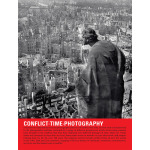I visited the Conflict Time Photography exhibition at the Tate Modern over the weekend. You can find reviews of it from The Daily Telegraph here, and from The Guardian here . As Alistair Snook suggests in the Telegraph, the basic premise of the exhibition is that the material is sorted by time. Thus he writes “instead of a chronological survey of war photography from the 19th century to today, Tate Modern organises the material according to the amount of time that has elapsed between the pictures and the conflicts they address.
Thus, the first section, “Moments Later”, contains images of the mushroom cloud produced by the atomic bomb dropped on Hiroshima, captured by a 17-year-old student just 20 minutes after the explosion, as well as Don McCullin’s famous shot from Vietnam of a shell-shocked US marine wearing the mentally quivering, awestruck expression of someone coming face-to-face with his maker.
Next, we find photographs taken days, weeks, or months after conflicts ranging from the Crimean War to the First Gulf War and Afghanistan. By the end of this ingenious exhibition, which telescopes through time, we are confronted with photographs recording aspects of the First World War that were made up to a century after the event.
This, then, is not an exhibition about photojournalism, which ordinarily casts the viewer with immediacy into wartime chaos and strife. Rather, it is about remembrance – about how artists, and by extension societies, come to terms with the atrocities and traumas of the past.”
As I will discuss in History Society, it was original, and for me at least it provoked unexpected conclusions. If you are in London before March, I strongly recommend it to you.
Mr Kydd.




